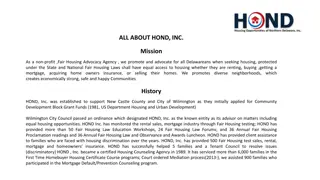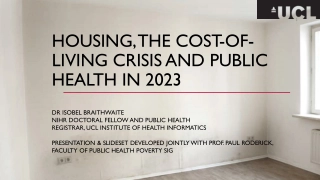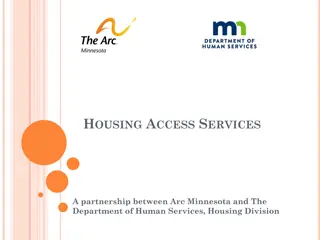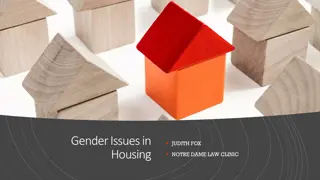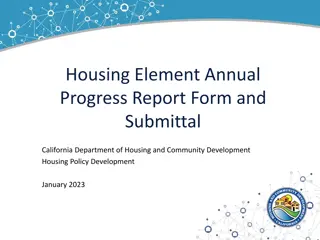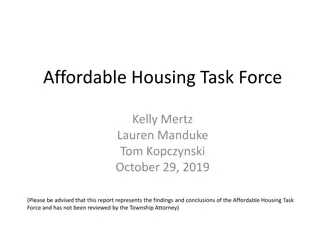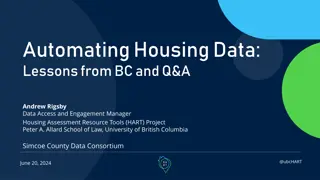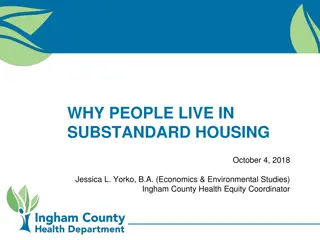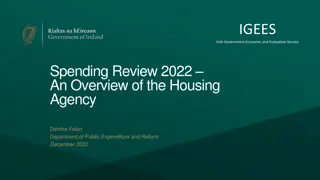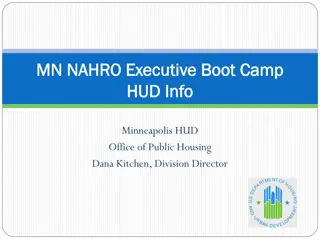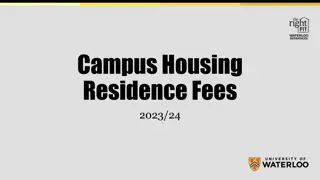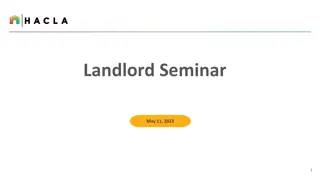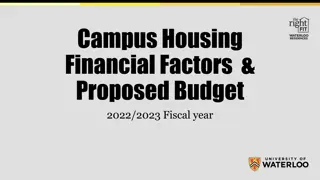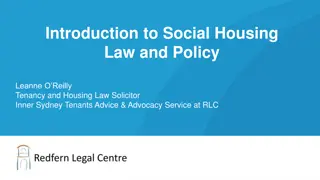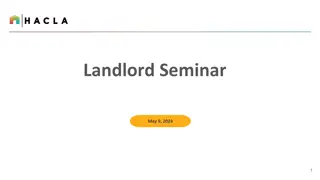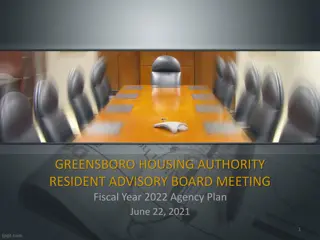Data Quality Workshop: Achieving Excellence in Housing Management
Explore the essentials of benchmarking, definitions in housing management, and the significance of data quality in repairs, lettings, collection/arrears, and satisfaction. Learn how benchmarking drives improvement, guides resource allocation, and enhances accountability for effective decision-making in social housing.
Download Presentation

Please find below an Image/Link to download the presentation.
The content on the website is provided AS IS for your information and personal use only. It may not be sold, licensed, or shared on other websites without obtaining consent from the author. Download presentation by click this link. If you encounter any issues during the download, it is possible that the publisher has removed the file from their server.
E N D
Presentation Transcript
Data quality workshop: getting it right repairs, lettings, collection/arrears & satisfaction Steve Smedley, Acuity
1) Benchmarking basics reminder 2) The definitions: Lettings/voids Collection & arrears Repairs & maintenance Satisfaction Agenda Order your coffee now, you ll need it
Benchmarking basics benchmarking = comparisons not everything that is performance managed needs to be benchmarked so, the question is: will comparisons provide additional insight? exploring variation in results to understand why is it so? What s the story? what good looks like - different approaches/good practice extent to which context is a factor setting evidence-based improvement targets to hold exec/board to account less is more: best focus on getting a smaller number of key metrics right how?: stick to the definition - might be different to how you traditionally count something alternative?: undermines credibility of data & ultimately the sector trust issues, corrosion, anarchy, zombie apocalypse
Benchmarking basics focused on benchmarking the primary forms of managedsocial housing = general needs, housing for older people & support (definitions on profile page) limited exceptions in financial metrics (eg overall margin, EBITDA) we capture other info on your profile page to provide essential biz context (eg other forms of housing, turnover, staffing levels) useful when picking a bespoke peer group when submitting end of year data, don t forget to ensure your profile is up to date
Benchmarking basics benchmarking is the start of a journey not the last word biz analysis tool (internal) evidence-based resource allocation & focused improvement work aim high - achieve ambition/mitigate risks in challenging circs create headroom/buffer transparency/accountability/political management tool (external) provide assurance of sound grasp of cost and performance, in context, internally & externally Biz Plan Review Cycle Past Future Benchmarking results + other quantitative & qualitative data Decisions Further investigation, priorities, resource allocation, improvement action Implement Evidence-based Biz Plans & VFM Strategy/Action Plans Insight Understand strengths, weaknesses, priorities Analysis What s the story? How are we doing?
Benchmarking basics it is not the answer or last word on VFM computer says no limitation of metrics - data means nothing without the story of why it is so often as much about context as it is about performance cost & performance/quality in the round, complemented with other info (eg qualitative), taken in context look at related metrics in conjunction eg: arrears reduced at expense of void loss? FTAs reduced by write-offs? good average void & repair times at expense of satisfaction? etc not a finely calibrated tool for league tabling, getting hung up on immaterial/minor apportionment, exposing individuals definitions can t legislate for every eventuality sometimes need interpreting based on what metric is trying to do clubs a useful forum to discuss TSM likely to change what benchmarking clubs collect going forward worthy topic for summer meetings?: what should you ditch? numerator = result denominator
All definitions available on data entry page by clicking on the blue ?
Key lettings/voids metrics tend to be differentiated by client group (GN, HfOP, Support) borrow heavily from CORE definitions GNPI/HMHO/HMHS 30 series - Percentage of rent lost through dwellings being vacant xxxx36 series + CMPI 03 + BV212 - Average re-let time (calendar days) xxxx39 series - Re-lets as a percentage of stock borrow heavily from CORE definitions tend to be differentiated by client group
xxxx 30 - Percentage of rent lost through dwellings being vacant Rationale: optimum use of social assets/revenue maximization, ROI foregone from unlet assets (Major Works included!) calculation: rent & service charges lost due to dwellings being vacant x 100 gross rent and service charges receivable denominator - gross rent and service charges receivable - total potential rent & service charges collectable for the period for all dwellings if all dwellings had been occupied dwelling may have been vacant for any reason - includes dwellings that are unavailable to let (eg MW & held for decant) But . if unavailable to let are not expected to be let as social dwellings again, eg awaiting demolition, they should be excluded from both numerator & denominator (ie ignore completely) if collecting 1/4ly numerator - year to date rent/service loss denominator prorata annual rent/service charge Watch out! unlike average re-let time, you include MW
xxxx36 series + CMPI 03 + BV212 - Average re-let time (calendar days) Rationale: efficiency of key biz process Isolates the majority of voids - standard/routine re-lets calculation: total # days (standard relet) properties were vacant in period # of (standard relet) lettings in period # of days vacant = # days between tenancy end date and tenancy start date calendar days 7 days in a week day property goes vacant does not count (nor day let because it s let!) can get 0 days, can t get negative standard/routine? no major works, new lets, successions, exchanges, voids held for decant in numerator or denominator MW never convert to standard/routine once work phase finished always stay separate definition of MW is critical (see next slide) only include voids in this calc once let & include whole time, eg it may have become void in the previous reporting period finally letting that long void has sting in tail!
..so whats a MW void? differentiating between standard/routine void & MW void comes down to detailed definition of MW: couldn t reasonably be carried out with tenant in-situ decant test = acid test ..typically such work is necessary for property to remain habitable, eg structural - essential to stability and weather resistance eg floors, walls and roofs. site works to area around (typically safety & security) services installations gas, electric, water, heating, ventilation, lifts work that significantly improves dwelling this may be relevant to those who upgrade whilst property void (can the decant test be applied?)
xxxx39 series - Re-lets as a percentage of stock Rationale: context for re-let time and void loss indicators, may indicate churn for whatever reason Calculation: number of properties re-let during the period x 100 number of properties managed Definition- re-lets as a proportion of the units managed exclude owned stock if not managed by you as with void loss, include dwellings vacant for any reason except where not to be used as social housing again (eg awaiting demolition)
Key rent collection & arrears metrics tend to be differentiated by client group xxxx210 series + GNPI 28 - Rent collected as a percentage of rent owed (excluding arrears b/f) xxxx220 series + CMCX13 - Current tenant arrears as a percentage of the annual rent debit SWBM 400, 410, 420 - Rent arrears net of unpaid HB
xxxx210 series + GNPI 28 - Rent collected as a percentage of rent owed (excluding arrears b/f) Rationale: efficiency of key process & income maximization/capacity Calculation: actual rent and service charge income received year to date x 100 actual rent and service charges due year to date (nb year to date is there for those who collect 1/4ly) solely interested in effectiveness of current collection process (arrears metrics are more historic & especially suited to trend analysis over time) possible to score over 100% if making headway into historic arrears exclude garages completely (in numerator or denominator) actual rent and service charge income received in the period (numerator) no adjustments for: late HB payments, pre-payments or post-payments ( arrears net of HB deals with late HB .2 slides time) other non rent/service charge items collected by landlord should be excluded if possible: water rates, court costs, repairs recharges, overpaid housing benefit etc if unable to split these out of rent collected, include them in both numerator and denominator. actual rent and service charges due (denominator) exclude rent lost due to properties being vacant exclude void loss (only count tenanted properties) current tenant arrears brought forward at the beginning of the year - only arrears here should be from current year
xxxx220 series + CMCX13 - Current tenant arrears as a percentage of the annual rent debit (total arrears) rationale: effective arrears process/income maximisation particularly useful over time (trend) calculation: actual current tenant rent & service charge arrears at period end x 100 annual rent/service debit for current financial year (exclude void loss) exclude: void loss from denominator (as previous metric) court costs/sundry debts, garages (as previous metric) arrears from previous tenancy, FTAs only interested in current rent/service arrears advance payments/credits (masks true arrears - not your - they can ask for it back) no adjustment for late HB (see next metric arrears net of HB it deals with technical arrears) denominator nerd alert for quarterly people Q. if collecting quarterly, how the devil do you provide annual rent debit for current financial year, excluding void loss? ..you don t know what voids you ll get!@~# A. whatever you have @ quarter end for rent debit excluding void loss is projected forward at Q1 I have 100,000 rent debit minus 1000 void loss = 99,000 at Q1, 13 weeks have elapsed so 99,000/13 gives me a weekly rent debit minus void loss of 7615 (if Q2, it would be 26 weeks) if I multiply 7615 by 52, I get a projected annual figure of 395,980
SWBM 400, 410, 420 - Rent arrears net of unpaid HB rationale, calculation & definition: as previous metric but this allows you to adjust for the HB cycle it deals with technical arrears simply exclude arrears due to late Housing Benefit payments
Key repairs & maintenance metrics repairs metrics apply across GN, HfOP & Supported housing SWBM 201 Average number of responsive repairs per unit HMPI 101 Percentage of repairs completed at the first visit HMPI 90 Average end-to-end time for all reactive repairs % repairs completed on target suite: HMPI 70 Percentage of all reactive repairs completed within target time GNPI 18 Percentage of emergency repairs completed within target time GNPI 19 Percentage of urgent repairs completed within target time GNPI 20 Percentage of routine repairs completed within target time HMPI 102 Percentage of residents satisfied with the most recent repair G15C0 Percentage of dwellings with a valid gas safety certificate G15C1 Percentage of gas safety checks completed within target
SWBM 201 Average number of responsive repairs per unit rationale: as much about context as performance? Useful can opener. High number: poor diagnostics, poor application of repairs policy, poor quality or simply about tenant or stock profile? calculation: Total number of responsive repair orders issued during the benchmarked period . Total number of GN, SH & HfOP units where the landlord is responsible for responsive repairs definition of reactive (or responsive ) is key: all minor, ad hoc/unplanned repairs (regardless of priority) that are reported by tenants or arise from damage/wear and tear to communal areas and common parts defect that is the landlord's responsibility to make good (as per Landlord and Tenant Act 1985) counting jobs rather than SOR lines a number of SOR tasks might be batched up into 1 job not an exact science especially if local practice involves batching lots together as part of annual visit can be teased out in a group - extent some members have composite orders or include/exclude handymen type repairs exclude repairs undertaken as part of a pre-determined maintenance programme eg gas (cyclical) including making good type repairs following cyclical works (if you can split them out) void repairs
HMPI 101 Percentage of repairs completed at the first visit formerly Percentage of repairs completed right first time metric has its problems was trying to expose poorly diagnosed, trained, organized and equipped council services back in 2000s (aimed to encourage multitrade operatives in vans with parts) tweaked over time to address perceived unfairness but now feels clunky fails to pick up that many small HA tenants happy for operative to nip to B&Q for parts definition says that this should not be counted because operative left & returned = 2 visits this metric discounted by RSH in TSM consultation calculation: # response repairs completed by operative without need to return a second time x 100 all responsive repairs completed (emergency, urgent & routine) now allows for multiple trade visits where essential and known in advance where job requires multiple trades, work completed first visit so long as each trade completes in one visit as planned exclude totally: diagnostic pre-inspections (no intention of repairing) metric is about remedial action only no access ?????arguably communal repairs??????
HMPI 90 Average end-to-end time for all reactive repairs supersedes old school % repairs completed on target (3 time bands in next slide) on basis that: old school - can set different targets for % repairs completed on target not a great basis for benchmarking!!!!!! a timely service is what tenants want shorter average suggests efficient process (but not satisfaction of course!) calculation: sum of the total number of calendar days taken to complete responsive repairs in the period total number of responsive repairs completed in the period definition: average number (calendar) days between responsive repair being requested and its satisfactory completion including the day of request and the day of completion date of satisfactory completion - decided by the landlord
% repairs completed on target suite HMPI 70 Percentage of all reactive repairs completed within target time GNPI 18 Percentage of emergency repairs completed within target time GNPI 19 Percentage of urgent repairs completed within target time GNPI 20 Percentage of routine repairs completed within target time calculation: sum of the total number of calendar days taken to complete [band] responsive repairs in the period total number of [band] responsive repairs completed in the period (ir)Rationale: as noted, with exception of emergency repairs, looks a bit dated originally conceived in 2000s to kick councils up backside OK to measure internally but comparing performance against targets when those targets might differ isn t really benchmarking (controversial perhaps) list of repairs for the various bands but local wiggle room too further undermines benchmarking kept alive by boards? should you be benchmarking this (bar emergency)? have a think
HMPI 102 Percentage of residents satisfied with the most recent repair now adopted by STAR as one of new core questions as such should conform to STAR method (covered at satisfaction section)
G15C0 Percentage dwellings with a valid gas safety certificate Rationale: assure all parties that landlord is complying (or otherwise) with the legal requirement to check and service all landlord owned gas appliances in their properties avoiding prison Calculation: number of dwellings with a current valid gas safety certificate as at the end of the period x 100 number of dwellings the landlord has a gas safety obligation under the Gas Safety Regs Definition: landlord must have copy of cert denominator number of rented dwellings in ownership that have a connected gas supply (not necessarily the total stock in ownership) where gas supply disconnected, these units are excluded from the denominator (landlord must hold an appropriate record confirming disconnection) tenanted properties with disconnected gas pipework should only be excluded if there is a record of annual checks to verify the gas supply is still disconnected
G15C1 Percentage gas safety checks completed within target similar but more challenging than previous snapshot with previous - lots of safety checks might fall out of 12 month deadline but you pull out all stops to have 100% on 31 March G15C1 more onerous identifies where a safety check has exceeded 12 months at any time in the year makes you put in place a systematic process ahead of 12 month expiry calculation: number of dwellings where a gas safety check was completed within 12 months of the previous one x 100 number of dwellings where a gas safety check was due under the Gas Safety Regs
Satisfaction surveying practice beyond scope of this session Basic calculation: number of respondents who are very or fairly satisfied x 100 total number of respondents to question primary satisfaction metrics from STAR you should adhere to the methodology here eg questions phrased specifically 5 response categories (with neutral middle) appropriate sample size for perception and transactional type Qs for small organisations this is tough it might mean a census rather than a sample! ie you survey everyone! online sample size calculator or (easier) handy spreadsheet included with these materials data collected as part of a methodologically sound STAR survey - results good to go remaining non-STAR satisfaction metrics are very transactional, eg satisfaction with ASB, complaints, etc small number of cases - will skew results (begs question of comparing them) but qualitative feedback useful advent of TSMs adhere to RSH guidance/harmonisation with STAR? Acuity is a key survey provider we can help you get it right end-to-end (from deciding what to ask to analysis and actionable insight) provide 3rd party assurance
TSM timetable Spring Summer 22 RSH analyses feedback from consultation Late Summer 22 RSH publishes decision statement, TSMs and technical guidance in anticipation of1 April 2023 implementation date. (Acuity plans to incorporate metrics so that members can pilot TSMs 2022-23 if they wish) Autumn 22 -Spring 23 Providers prepare systems April 2023 - March 2024 Providers collect first year of data Summer 2024 Providers submit data to regulator Autumn 2024 RSH publishes 2023-24 provider data
Get in touch about any further issues steve.smedley@arap.co.uk 07814 424426











